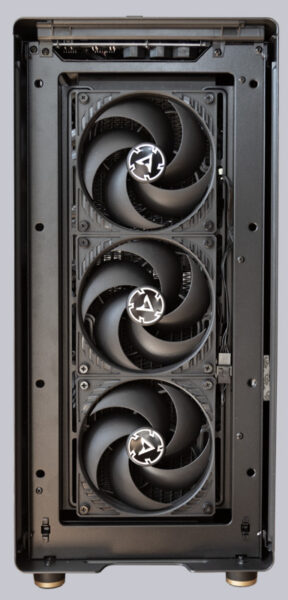
Test setup and results …
The test system with which we determined the following measured values comprises the following components …
| Motherboard | ASRock B650E Taichi with M.2 PCIe 4.0 x4 interface |
| SSD | Crucial P5 Plus 1TB M.2 PCIe 4.0 NVMe-1.4 CT1000P5PSSD8 |
| CPU | AMD Ryzen 5 7600X |
| RAM | 2x 16GB DDR5-5600 from Crucial |
| PSU | Cooler Master V750 Gold |
| Graphics card | AMD Radeon RX6800XT |
| Case | Fractal Design North |
| Cooling | Arctic Liquid Freezer II 360 |
| Operating system | Windows 11 – Version 22H2 |
Before the test with the MagFlow fan was carried out, the currently installed fans had to prove their performance. The individual cables and connectors of each fan are also clearly visible, which doesn’t leave a particularly pretty impression.

Control …
Two of the tested MagFlow 120 fan from Seasonic started spinning in DC mode from 3.9 volts, the third one started only at 4.9 volts. It’s a different story in PWM mode. Standstill is not possible in PWM mode, where the speed from 0-10% PWM is 630 rpm. After that, the speed increases by about 80 rpm per 5% PWM increase until the maximum speed of 2000 rpm is reached, which is even exceeded a bit when free spinning.
Power consumption …
During the startup phase, the power consumption of a MagFlow 120 fan is up to 0.25A for a short time, and at full speed the current consumption settles at about 0.13A, which is a good value for a 120mm fan at 2000 rpm. If the fan blocks, it draws up to 0.65A for about 1 second and then shuts down. Fortunately, the power supply does not have to be interrupted for the fan to start up again by itself when it is free again.
Loudness …
We determine the volume at a distance of 50cm measured from the front of the case. This corresponds to a setup with a PC standing on the desk. We regulate the case fan to 30%, because our measuring device does not show any further noise reduction below that, which is the starting point for the volume measurement of the Seasonic MagFlow 120 Fan. With this measurement method, we can determine the influence of the volume on the overall system. The following volume data always refers to the entire test system and not to the MagFlow Fan alone. Apart from the TestFan, two 140mm fans and three 120mm fans are installed in the case. The fans in the graphics card and the power supply were not in use during the test.
All case parts were closed during the volume measurement to correspond to a practical operation. We determined the following noise levels at different fan speeds with 3 MagFlow 120 fans in the front of the case on the 360mm radiator, whereby the case fans always ran at 30% PWM.
| PWM | Speed | Loudness |
| 10% | 630 rpm | 32dBA |
| 20% | 815 rpm | 32dBA |
| 30% | 1000 rpm | 33dBA |
| 40% | 1160 rpm | 34dBA |
| 50% | 1310 rpm | 36dBA |
| 60% | 1460 rpm | 37dBA |
| 70% | 1620 rpm | 38dBA |
| 80% | 1760 rpm | 40dBA |
| 90% | 1920 rpm | 42dBA |
| 100% | 2050 rpm | 44dBA |
Our measured values attest the MagFlow 120 fan an averagely high volume. Compared to other fans we have already tested, they are neither particularly loud nor particularly quiet. Apart from a discreet whistling sound at 65% PWM, the fans run free of noticeable vibrations or noise from the low to the high speed range, which makes them pleasantly tolerable representatives of their guild. At PWM values above 80%, the MagFlow fans clearly drown out the rest of the test system, but without producing a particularly unpleasant sound.
Cooling performance …
To determine cooling performance, we use the Cinebench R23 benchmark to simulate a high workload on the processor under near real-world conditions without stressing the CPU abnormally high like the Prime 95 Small FFT test would. The AMD Ryzen 7600X processor used in the test was overclocked with PBO and consumed an average of 108 watts during the Cinebench R23 infinite loop. To make matters worse, the room temperature was a summery 30°C, but with the Thermal Throttle Limit set to 95°C, this did not cause the CPU to throttle during the test.
| PWM | Speed | CPU Temp. |
| 45% | 1100 rpm | 87°C |
| 50% | 1300 rpm | 86,5°C |
| 60% | 1450 rpm | 86°C |
| 65% | 1530 rpm | 85,5°C |
| 70% | 1600 rpm | 85°C | 100% | 2040 rpm | 85°C |
The temperature readings with the Seasonic MagFlow fan practically do not differ compared to the original fan of the Arctic Liquid Freezer II 360 water cooling system used. Only at PWM settings of less than 70% does the cooling performance drop in our test setup and the CPU temperature starts to rise slightly. At 45% PWM, the CPU temperature is only 2°C more than at full speed and the noise level is barely above the base volume of the test system. Thus, the Seasonic MagFlow 120 fan is also great for cooling a radiator and building a quiet PC, as we were able to keep our test PC with AMD Ryzen 7600X processor at 35dB and even below at 30° room temperature with no problem, despite stress testing the CPU.
Seasonic MagFlow 120 Result and general impression …

